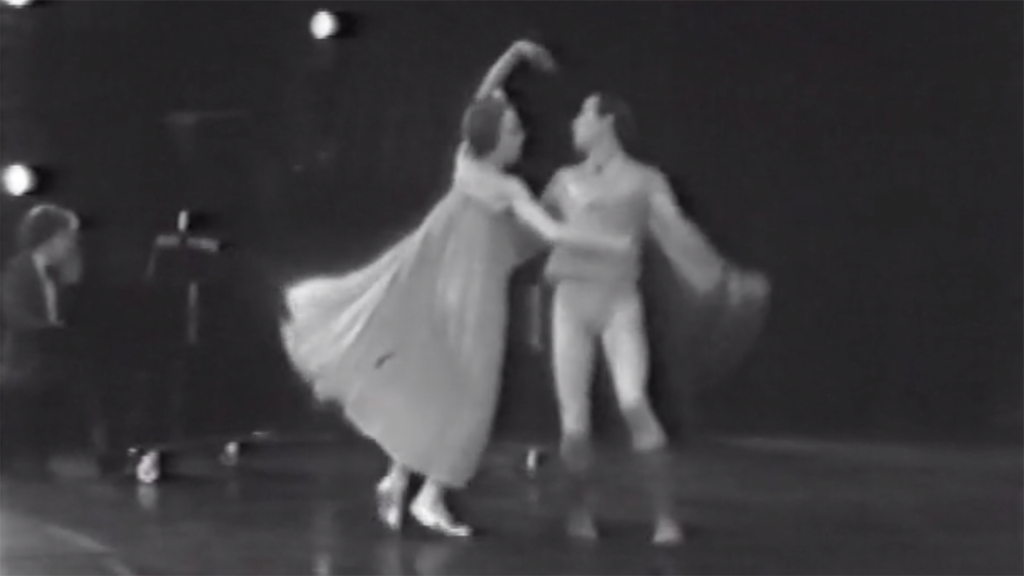Dance Heritage Video Archive project collects historical dance footage
June 28, 2019

Les Ballets Trockadero de Monte Carlo in Berkeley, 1977 | Photo courtesy DHVA
The ephemeral nature of dance as an art form is widely discussed throughout the medium. How, scholars ask, can we archive the history of a movement that begins and ends with the blink of an eye? A new project at the USC Libraries is taking one approach to this eternal problem.
With support from the Andrew W. Mellon Foundation, the USC Libraries and USC Glorya Kaufman School of Dance created the Dance Heritage Video Archive (DHVA). According to the library website, the archive itself is a digitized collection. It primarily “preserves culturally significant recordings that document global and U.S. dance traditions, creative work by outstanding choreographers and performers, and performances that helped to advance the art form.”
Digitization as a means of preservation
The project not only digitizes to preserve video content that holds relevance to dance history, but it also aims to share the content with a wide audience. The USC Digital Library presently provides access to about 280 of 1,200 videos that the Dance Heritage Coalition previously digitized at hubs in New York, San Francisco and Washington, D.C. Consequently, the DHVA project’s first step was to transfer the digitized recordings of dance performance, research, interviews, meetings and more to USC. Now, they’re working on making it publicly available online. This step includes clearing rights with artists in order to publish content without restrictions. Videos with remaining restrictions will be accessible for a smaller audience: dance educators, universities, etc.
“In general, the Dance Heritage Video Archive project is concerned with digitization of endangered or potentially endangered cultural products, things that were on obsolete media forms. Often, choreographers will have a treasure trove of archival materials. However, they don’t necessarily have the means or the resources to organize, categorize and especially digitize,” said Alison D’Amato, a USC Kaufman professor who works with the DHVA team.
USC Kaufman’s role in gathering materials
D’Amato and USC Kaufman professor Patrick Corbin joined the DHVA team to provide expertise in dance and its history.
“The USC Libraries spearheaded the project,” said D’Amato. “Professor Corbin and I were excited to learn about the resource. With our backgrounds and research interests in dance history, we were eager to get involved.”
The two serve as liaisons to the library. They advise where necessary and communicate between the library team and the dance world. Now that publication of the original 1,200 videos has begun, D’Amato and Corbin are working toward phase three. Essentially, this phase requires seeking new materials relevant to the project. Along with Project Librarian Javier Sepulveda Garibay, they are reaching out to artists whose materials may be “vulnerable,” meaning the artists do not have resources to digitize the footage themselves. In the coming future, the DHVA team aims to increase access in general to these archived digital materials. With a global platform, artists, teachers and students alike can access the cultural materials through the web.
“We have a long way to go in the dance field in terms of accessibility,” D’Amato said. “But accessibility is really important to us in this project, and these artists do want their work to be shared.”
Where D’Amato’s expertise comes in
D’Amato finds that DHVA aligns well with the skills she brought to USC Kaufman. In her studies, she accumulated an arsenal of expertise on dance and scoring. Accordingly, her ideas on preservation of dance and choreography transfer easily to archiving dance through video.
“I spend a lot of time thinking about the tension between dance and perpetuation and stability. Subsequently, those theoretical issues have been the subject of my writing for many years,” she said.
As a historian and educator, she believes wide availability to historical dance materials could significantly change the field.
“In historical research, having access to video materials is so critical. A lot of dance historians, researchers, and even teachers have tremendous difficulty accessing the materials they need,” she said. “We’re often limited to short clips. Occasionally, clips lack adequate credits or other important contextual information.”
Access to an archive of full-length works at high quality, along with supplementary material—rehearsals and discussions, etc.—will give global audiences a markedly larger context for the work and a deeper look into dance.
What’s next for the archive
Currently, the video archive is openly available through the USC Digital Library to anyone within and beyond the university community. Furthermore, D’Amato notes that the materials highlight New York dance history. That, however, will soon change. Moving forward, USC Kaufman and its community will provide links to more footage from West Coast dance lineage. In addition, the DHVA team will continue to digitize other audiovisual recordings in hopes of preserving United States, and subsequently global, dance heritage.
“We’re beginning to use USC Kaufman faculty’s connections to diversify the roots from which we seek material,” D’Amato explained.
Lastly, she hopes that it will become an engaging and functional interface. The project ultimately has potential to become a resource that serves many different audiences.
Until then, DHVA resources and archives are accessible online at the USC Digital Library.
For inquiries about submitting content to DHVA, contact Javier Sepulveda Garibay at jgaribay@usc.edu.
By Celine Kiner